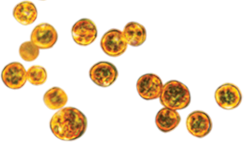
Washington state is widely known for its natural beauty and ecological diversity. The local waters are not only a beauty defining feature for the region, but it is also tremendously foundational for many communities. Residents and industries heavily rely on local waters and seafood. Native tribes in the state have built a strong cultural connection with the shellfishes and fishes native to the area. The state is also home to the most shellfish farms in the country and, therefore, depends on the water's health. Recreational fishing and shellfish harvesting are also popular activities that require good water quality. Harmful algae have been a common threat for water quality, shellfishes, and fishes in the state. The damaging effects have directly affected local communities, ecosystems, and economies. Locals reported numerous farm shutdowns and crop die-offs caused by harmful algae, and we anticipate similar events in the future. In 2006, Northwest Fisheries Science Center (NWFSC) with funding from NOAA's Ocean and Human Health Initiative created SoundToxins--a Puget Sound phytoplankton monitoring program--to mitigate the problems by alerting the state health department about the presence of potentially harmful plankton and advance methods for early detection and prediction to protect our region better. The program initially started with four partners, and now, in 2020, the number has grown to 27 partners. Although the monitoring efforts are now led by Washington Sea Grant (WSG), these diverse partnerships continues to power the program.
The overall goal of this cooperative partnership is to establish a cost-effective monitoring program that will be led by state managers, environmental learning centers, tribal harvesters, and commercial fish and shellfish farmers. The SoundToxins program aims to provide sufficient warning of HAB events to enable early or selective harvesting of seafood, thereby minimizing risks to human health and reducing economic losses to Puget Sound fisheries.
The objectives of the SoundToxins program are
The program primarily monitors phytoplankton in Puget Sound known to harm humans, ecosystems, and economic health. The phytoplankton of interest are Alexandrium, Dinophysis, Heterosigma, and Pseudo-nitzschia. In 2019, SoundToxins included Akashiwo sanguinea, Phaeocytsis, and Protoceratium reticulatum to that list. Additionally, participants collect information about environmental parameters. Monitoring happens routinely, weekly in-season, and bi-monthly offseason. These efforts help the program continuously look for patterns and create methods to mitigate damages to our communities' health and seafood industries.
SoundToxins provides the tools and material required for monitoring to partners. These include but are not limited to microscopes, slides, plankton nets, vials, preserves, and SoundToxins database user account to upload observations. The program also provides formal trainings to participants where safety while monitoring is emphasized. Partners may send any questions or concerns to SoundTox@uw.edu.
The partnerships consist of members who are incredibly passionate about the health of our ecosystems. The collaboration allows SoundToxins to continuously look for patterns and develop methods to mitigate damages to our communities' health and seafood industries.